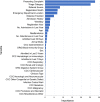Development of a low-dimensional model to predict admissions from triage at a pediatric emergency department
- PMID: 35859857
- PMCID: PMC9286530
- DOI: 10.1002/emp2.12779
Development of a low-dimensional model to predict admissions from triage at a pediatric emergency department
Abstract
Objectives: This study aims to develop and internally validate a low-dimensional model to predict outcomes (admission or discharge) using commonly entered data up to the post-triage process to improve patient flow in the pediatric emergency department (ED). In hospital settings where electronic data are limited, a low-dimensional model with fewer variables may be easier to implement.
Methods: This prognostic study included ED attendances in 2017 and 2018. The Cross Industry Standard Process for Data Mining methodology was followed. Eligibility criteria was applied to the data set, splitting into 70% train and 30% test. Sampling techniques were compared. Gradient boosting machine (GBM), logistic regression, and naïve Bayes models were created. Variables of importance were obtained from the model with the highest area under the curve (AUC) and used to create a low-dimensional model.
Results: Eligible attendances totaled 72,229 (15% admission rate). The AUC was 0.853 (95% confidence interval [CI], 0.846-0.859) for GBM, 0.845 (95% CI, 0.838-0.852) for logistic regression and 0.813 (95% CI, 0.806-0.821) for naïve Bayes. Important predictors in the GBM model used to create a low-dimensional model were presenting complaint, triage category, referral source, registration month, location type (resuscitation/other), distance traveled, admission history, and weekday (AUC 0.835 [95% CI, 0.829-0.842]).
Conclusions: Admission and discharge probability can be predicted early in a pediatric ED using 8 variables. Future work could analyze the false positives and false negatives to gain an understanding of the implementation of these predictions.
© 2022 The Authors. JACEP Open published by Wiley Periodicals LLC on behalf of American College of Emergency Physicians.
Conflict of interest statement
All authors have no conflicts of interest to disclose.
Figures


Similar articles
-
Predicting emergency department inpatient admissions to improve same-day patient flow.Acad Emerg Med. 2012 Sep;19(9):E1045-54. doi: 10.1111/j.1553-2712.2012.01435.x. Acad Emerg Med. 2012. PMID: 22978731
-
Predicting Admissions From a Paediatric Emergency Department - Protocol for Developing and Validating a Low-Dimensional Machine Learning Prediction Model.Front Big Data. 2021 Apr 16;4:643558. doi: 10.3389/fdata.2021.643558. eCollection 2021. Front Big Data. 2021. PMID: 33937750 Free PMC article.
-
Predicting hospital admission at emergency department triage using machine learning.PLoS One. 2018 Jul 20;13(7):e0201016. doi: 10.1371/journal.pone.0201016. eCollection 2018. PLoS One. 2018. PMID: 30028888 Free PMC article.
-
A Machine Learning Approach to Predicting Need for Hospitalization for Pediatric Asthma Exacerbation at the Time of Emergency Department Triage.Acad Emerg Med. 2018 Dec;25(12):1463-1470. doi: 10.1111/acem.13655. Epub 2018 Nov 29. Acad Emerg Med. 2018. PMID: 30382605
-
Clinical Decision Support Systems for Triage in the Emergency Department using Intelligent Systems: a Review.Artif Intell Med. 2020 Jan;102:101762. doi: 10.1016/j.artmed.2019.101762. Epub 2019 Nov 17. Artif Intell Med. 2020. PMID: 31980099 Review.
Cited by
-
Use of Artificial Intelligence in Triage in Hospital Emergency Departments: A Scoping Review.Cureus. 2024 May 8;16(5):e59906. doi: 10.7759/cureus.59906. eCollection 2024 May. Cureus. 2024. PMID: 38854295 Free PMC article.
-
Factors predictive of hospital admission for children via emergency departments in Australia and Sweden: an observational cross-sectional study.BMC Health Serv Res. 2024 Feb 23;24(1):235. doi: 10.1186/s12913-023-09403-w. BMC Health Serv Res. 2024. PMID: 38388438 Free PMC article.
References
-
- Dinh MM, Russell SB, Bein KJ, et al. The Sydney Triage to Admission Risk Tool (START) to predict emergency department disposition: a derivation and internal validation study using retrospective state‐wide data from New South Wales, Australia. BMC Emerg Med. 2016;16(1):46. 10.1186/s12873-016-0111-4 - DOI - PMC - PubMed
LinkOut - more resources
Full Text Sources
